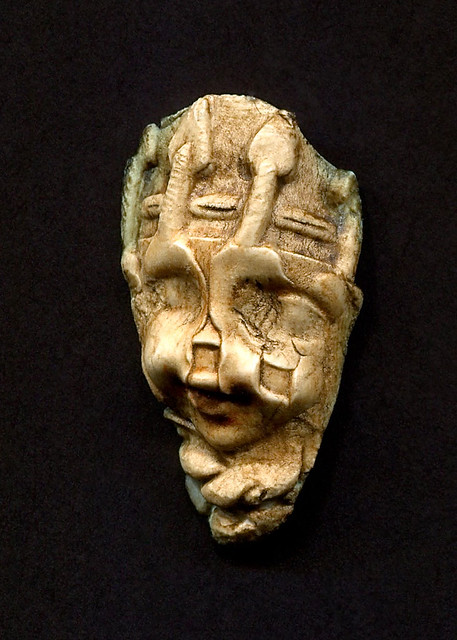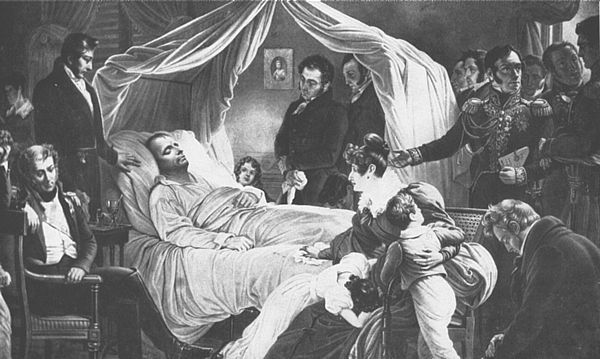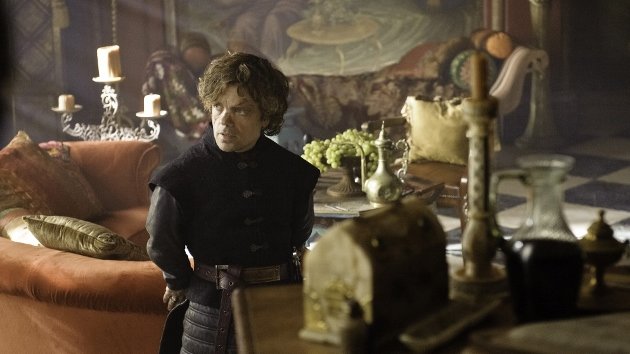Image source: http://darboriasworld.wordpress.com/2010/09/13/que-veulent-reellement-les-femmes/
 http://www.sfsu.edu/~medieval/romances/wedding_rev.html
http://www.sfsu.edu/~medieval/romances/wedding_rev.html
Lythe and lystenyth the lif of a lord riche!
The while that he lyvid was none hym liche,
Nether in bowre ne in halle.
In the tyme of Arthoure thys adventure betyd;
And of the greatt adventure, that he hymself dyd,
That Kyng curteys and royall.
The Weddyng of Syr Gawen and Dame
Ragnell for Helpyng of Kyng Arthoure (1-6)
Harken and listen to the life of a rich lord! While he lived, there was no one like him anywhere. In his day, the courteous and royal King Arthoure had a great adventure. Of all kings Arthoure was the flower, and he bore the honour of all knighthood wherever he went. There was nothing but chivalry in his country, for he loved knights and reviled cowards. Now, if you will listen to me for a while, I will tell you how it once befell, when he was hunting with his bold knights in Inglewood—now hear my story!
The king was in his blind with his bow ready to slay the wild game, and his lords were beside him. As he stood up, he became aware of a great, fair hart and quickly went forth. The deer heard the hounds and stood hidden in a fern thicket. The king saw all this and told his men to stay there and he would stalk the deer alone. He took his bow and, hunstmanlike, stooped low to creep up on the deer. When he came near, the hart leapt into a briar patch, and the king kept coming closer and closer. So the king chased the deer (I believe half a mile) by himself and finally let a shot fly and hit the deer, with God’s grace, so that it trembled and fell into a great fern brake. The king followed fast and after he dashed out its brains, he tested the fat. As he was with the deer, a strange man, well armed, mighty and strong, came up to him and spoke grimly:
“Well met, King Arthoure! You have wronged me for many years, and I will grievously requite you now; your life is nearly done. You have wrongly given my lands to Sir Gawain. What do you say, here alone?” Arthoure asked the man his name, who replied, “Gromer-Somer Jour.”
“Ah!” said Arthoure. “Think well. You are a knight and to slay me here will bring you no honour; you will be forever shamed and knights will refuse you everywhere. Let go of your will and use your wit, and I will amend what is amiss, if you allow it, before I go.”
“No, by heaven, you won’t escape!” said Sir Gromer-Somer. I have you in my power and shall not fail. If I let you go lightly now, you will defy me another time.”
“Save my life,” answered the king, “and by God I will grant whatever you want. You will have shame if you kill me while I am hunting, dressed only in green, while you are armed.”
“All this won’t help you,” was the reply. “I want neither land nor gold. Unless you agree that on a certain day that I set and in the same array—“
“Yes!” interrupted the king. “Here is my hand!”
“Wait, King, and listen to me a while. First, you will swear upon my bright sword to tell me, when you come, what women everywhere love best. You will meet me here alone in twelve months, and if you don’t bring the answer, you will lose your head. This will be your oath. What do you say? Have done with it!”
“Sir, I agree, though it is loathsome to me. Now let me go. I assure you, as I am a true king, that I will come again in twelve months and bring you the answer.”
“Go your way, King Arthoure; your life is in my hand, I am sure. You don’t realize your trouble. Wait! Be sure that you are not deceiving me today, and that you keep everything secret. By Mary, if you tried to betray me in battle, you would lose your life.”
“That will not happen,” the king assured him. ‘I would rather die than be a faithless knight. Farewell, sir, and evil met. If I am alive, I will be here on the day set, even if I know I will not escape.”
The king blew his horn, and all his knights came quickly. They found him and the deer, and he had a sad expression and no desire for sport. He told them he did not care to hunt and they were to go home. All the lords knew by the look on his face that the king had met with some disturbance. At Carlisle the king had a heavy heart, but no one knew what troubled him. Finally Sir Gawain asked him what was wrong, and the king answered immediately:
“Today in the forest I met a knight in his armor who said certain things to me that he asked me not to repeat. I must therefore keep secrecy or be a betrayer.” Gawain told him not to fear, for he would never dishonor him, and the king told the knight his story.
“As you know, hunting in Inglewood today I slew a hart by myself. There I met an armored knight named Sir Gromer-Somer Jour who would have fiercely slain me without mercy, but I spoke courteously to him as I had no weapons with me. My honour is therefore lost. I did not want to die, so I swore that at the end of twelve months I would met him there, dressed as I am now, and tell him what women want most or lose my life. I had no choice but to make this oath and never tell it to another person. Don’t blame me for being sorrowful, for this is the cause of my dread and fear.”
“Sir, make good cheer,” advised Gawain. “Ride your horse into strange country and ask every man and woman for their answer, and I shall ride the other way and do the same and write what I find in a book.” Arthoure thought this was good counsel, and soon they rode their separate ways to ask everyone what women desired the most. Some said they loved to be well adorned, some said they loved to be sweetly wooed, some said they loved a lusty man who can hug and kiss them. Some said one thing and some another, so that Sir Gawain had a huge book full of answers by the time he was to go back to court.
The king also returned with his book, and they looked at each other’s findings. Gawain felt sure the king could not fail, but Arthoure was still extremely fearful: “I think it best to search a little more in Inglewood Forest. I have only a month left, and I may hit upon some good news.”
“Do as you like,” said Gawain. “I am satisfied with whatever you do; it is good to be questioning! Doubt not, lord, that you will succeed. Some of your sayings will help when needed, or it will be disappointing!”
King Arthoure rode on the path into Inglewood the next day and met as ugly a woman as ever seen by far, and he certainly marveled. Her face was red and covered with snot, her mouth huge, and all her teeth yellow, hanging over her lips. Her bleary eyes were greater than a ball, and her cheeks were as broad as women’s hips. She had a hump on her back, her neck was long and thick, and her hair clotted into a heap. She was made like a barrel, with shoulders a yard wide and hanging breasts that were large enough to be a horse’s load. No tongue can tell of the foulness and ugliness of that lady.
She sat on a horse that was adorned with gold and precious stones; it was unseemly and puzzling to see such a fowl creature riding so gaily, I assure you. She rode up to Arthoure and greeted him:
“I am very pleased that I have met you. I advise you to speak with me before you go, for your life is in my hands.” The king asked what she wanted, and she told him she had good news for him. “None of the answers of which you can boast will help you, as you will find out. I know all about your secret, and if I don’t help you, you are but dead. If you grant me one thing, I will guarantee your life; otherwise you will lose your head.”
“Tell me quickly what you mean,” the king replied. “I don’t need you and greatly dislike your words. What do you desire, fair lady? Explain why my life is in your hands and I will honour your request.”
“Truthfully,” she said, “I am not wicked! Here is the covenant I would make with you: if the answer I give you saves your life, you must grant me marriage to Sir Gawain. Consider carefully, Sir King, and decide quickly; unless you agree, you will die.”
The king answered, “By Mary, I cannot promise that Sir Gawain will marry you; he alone can decide. But in order to save my life, I will do what I can and appeal to him.”
“Good!” she said. “Now go home and speak fair words to Sir Gawain. Though I am foul, I am lusty, and through me he may save your life.”
The king replied, “He will be loath to refuse my request, but I would regret causing Gawain to wed the foulest lady I have ever seen. I don’t know what to do.”
“Sir King, though I am foul, even an owl may choose its mate. I’ll say no more. I will meet you here when you have made your decision, or else I believe you are lost.” “Farewell, lady foul,” said the king. “Yes, sir,” she replied, “there is a bird men call an owl, yet I am a lady.” “Please tell me, what is your name?” “Sir King, I am called Dame Ragnell, who has never yet beguiled man.” “Dame Ragnell, have a good day.” “Sir King, God speed you on your way! I shall meet you right here.” They parted, and Arthoure returned to Carlisle, his heart heavy.
The first man he met was Sir Gawain, who asked how he did, and the king told him things went so badly that he was close to killing himself, since he was doomed to die. “No!” said Gawain. “That may not be! I’d rather die myself; these are ill tidings!”
“Gawain, today I met the foulest lady that I have ever seen, without doubt. She said she would save my life, on the condition that you will be her husband. Thus is my heart mournful.”
“Is that all?” said Gawain. “I’ll wed her, and would even if she were a fiend, or as foul as Beelzebub; otherwise I would not be your friend. You are my king and have honored me in many a battle; therefore I will not hesitate. It is my duty to save your life and my honor rather than be a false coward.”
“Gawain, I met her in Inglewood. Her name is Dame Ragnell, and she told me that unless I had her answer, all my labors would be useless. If her answer, and only hers, helped me, then she would have you; but if it did not, she would have none of her desire. There it stands, as she made the warrant.”
“I shall not fail,” said Gawain. “I will marry her at whatever time you set, so don’t worry. If she were the foulest creature ever seen, for love of you I would not hesitate.”
“Many thanks, Gawain!” said King Athoure. “You are the best knight I have ever found. You have saved my honor and life forever, and I shall love you as long as I am king of this land.”
Then within five or six days Arthoure had to return to Inglewood with his answer. Sir Gawain accompanied him until they were inside the forest, where the king told him they must go separate ways: “Farewell, Sir Gawain. I must go west and you may come no farther.” “My lord, God speed you on your journey. I would prefer to ride your way and am sorry to depart.”
Within a mile Arthoure met Dame Ragnell, who welcomed him. “Since there is no other way,” said the king, “tell me now the answer that will save my life. Gawain has promised to marry you, and you shall have your desire in the bedchamber and in bed. So tell me now quickly what will help. Have done, I cannot tarry!”
“Sir, you will now know, without digression, what women of all degrees want most,” Dame Ragnell responded. “Some men say we desire to be beautiful and that we want to consort with diverse strange men; also we love lust in bed and often wish to wed. Thus men misunderstand women. Another idea they have is that we want to be seen as young and fresh, not old, and that women can be won through flattery and clever ploys. In truth, you act foolishly. The one thing that we desire of men above all else is to have complete sovereignty, so that all is ours. We use our skill to gain mastery over the most fierce, victorious and manly of knights. So go on your way and tell this to the knight, who will be angry and curse the one who taught it to you, for his labour is lost. I assure you that your life is now safe, and remember your promise.”
The king rode as quickly as he could, through mire, moor and fen, to the assigned place. He met Sir Gromer there, who sternly demanded the king’s answer. Arthoure showed him the two books, which the knight studied carefully but did not find the right answer and prepared to kill the king, but Arthoure stopped him.
“Wait, Sir Gromer! I have one answer that will secure all.”
“Show me, or so help me God, I will take your life, with great pleasure I assure you.”
“Now,” said the king, “I see little nobility in you, by God who is always helpful. Here is what all women desire above all things of men, both free and bond: sovereignty, the rule of the manliest men. Then they are happy (so they have taught me)—to rule you, Sir Gromer.”
“I hope that she who told you burns in a fire, the old nag, for she was my sister, Dame Ragnell. God give her shame! If not for her, I’d have had you; now I’ve lost much travail. Alas that I ever saw this day! Go wherever you please, King Arthoure, for you are safe from me. I know well that you will now be my enemy, and I’ll never have you at such a point again. My song may be ‘Wail-away!’”
“No!” said the king. “I’ll make sure of that. I swear to God that I will be armored so that I can defend myself. You’ll never find me at such a disadvantage again, and if you do, let me be beaten and bound as your proof.” They bid each other farewell, and Arthoure was glad to have succeeded. He turned his horse into the plain and soon met Dame Ragnell in the same place as before.
“Sir King, I am pleased you have done well, as I told you it would be. Now you must keep your promise, since you were saved by my answer and none other. The noble knight Gawain must marry me.”
“I will not fail to keep my promise,” said Arthoure. “You will have your desire if you follow my advice.”
“No, Sir King, I will not do so. I will be married openly before I part from you, or you will be shamed! You ride ahead of me and I will follow you to your court. Remember how I have saved your life; therefore you should cause me no strife, which would be blameworthy.” Despite the king’s embarrassment, she rode forth until they arrived at Carlisle and entered the court beside him, to the king’s dismay. Everyone wondered where she came from, for they had never seen anyone so foul. She went into the hall with confidence and told Arthoure, “Sir King, bring Sir Gawain to me before these knights without delay so that we may be betrothed, for better or worse, before all your company. This is your promise, so let it be done! Fetch Sir Gawain, my love, immediately, for I will wait no longer!”
Sir Gawain arrived, ready to fulfill his promise, and Dame Ragnell was so impressed with his goodness that she wished she were beautiful for him. He pledged his troth to her as a true knight, and then Dame Ragnell was pleased! The queen cried “Alas!” and she and her ladies wept for Sir Gawain. The king and his knights also said, “Alas that Gawain should wed such a creature!” for she was so foul and horrible. She had two teeth on each side like boar tusks the span of a hand: one went up, the other down. Her wide, foul mouth was covered with grey hairs and her lips lay lumped on her chin; no neck could be seen. She was indeed a loathly one!
Dame Ragnell insisted on a wedding attended by all the ladies of the shire, both in town and borough, and had them summoned. When the day arrived that the foul maid should be married to Sir Gawain, the ladies cried “Alas!” and the queen asked Dame Ragnell to have a private ceremony early in the morning, but she refused:
“Nothing you can say will change my mind. I will be married publicly, according to the covenant I made with the king. I will go to the church at high mass time, and I will dine in the hall amidst all the company.” The queen agreed but began to suggest how Dame Ragnell might better keep her honor when the hag interrupted her:
“As for that, God you save, I tell you without boasting that I will have my honour today.” She prepared herself to go to church, where people of all degrees were waiting. She was more richly dressed than the queen in clothing worth three thousand marks of strong, stiff red coins. But for all her raiment, she was still the foulest sow ever seen.
To make a short conclusion, after the wedding they all went home to dine. There was abundant game, both wild and tame; in King Arthoure’s court there was no lack of that which can be caught in forest or field. Dame Ragnell headed the high table, and everyone remarked on her bad manners. When served, she ate as much as six people would, which amazed all. She used her nails, which were three inches long, to crudely break her food, so she ate alone. She ate three capons, three curlews and many baked meats; nothing came before her that she didn’t eat, which made everyone marvel, and both knight and squire bade the devil to gnaw her bones. So she ate until the meal was done and they had washed, as is the custom.
1
After the feast and entertainment, Sir Gawain and Dame Ragnell retired to the bedchamber and the lady said to the knight, who had his back turned toward her:
“Ah, Sir Gawain, since we are married, show me your courtesy in bed; it cannot be rightfully denied. If I were beautiful, you would do differently, but you take no heed of wedlock. But for Arthoure’s sake, kiss me at least. I pray you honor my request; show me how you can do.”
“I will do more than kiss you, and before God!” replied the knight, and when he turned around to face her, he saw the fairest creature he had ever seen. Then she asked him his will, and in astonishment he asked, “What are you?”
“Sir, I am your wife, of course. Why are you acting so strangely?”
“Lady, forgive me. I am to blame, fair dame. I was not expecting this; you are a lovely woman, and today you were the ugliest person I’ve ever seen. I am happy to have you like this,” and he embraced and kissed her with great joy.
“Sir, you must make a choice, as my beauty will not last. You may have me fair at night and foul at day in everyone’s sight, or fair during the day and foul at night. You must choose one or the other; which would you prefer to save your honor?”
“Alas,” said Gawain, “the choice is hard! To have you fair only at night would sorely grieve my heart and take away my honor. And if I desire to have you beautiful at day time, at night I would have meager reward. I would like to choose what is best, but I have no idea what to say, so I give you the choice; do as you like. Whatever you wish, I put it in your hand. My body and goods, heart and every part of me is all your own to buy and sell, I vow before God.”
The lady said, “Thanks to you, courteous knight; may you be blessed, for now I am honored. You will have me fair both day and night as long as I live. So don’t be grieved. I was misshapen through necromancy by my stepmother—God have mercy on her! By her enchantment, I was to remain deformed until the best knight in England married me and gave me the rule of all his body and goods, which you, courteous Gawain, have done, and have given sovereignty to one who will never anger you. Kiss me now, Sir Knight, and be of good cheer.”
They made much joy, the two of them alone, as was reasonable and natural. She thanked God and Mary that she had recovered from her defilement, as did Sir Gawain. They stayed awake all night in mirth and joy, and when she would arise, he stopped her and said they would sleep until prime
2 and let the king call them to dine, and she agreed. Thus it passed to midday, when Arthoure felt it was time to check on them: “Sirs,” he said to his knights, “Let’s go and see if Sir Gawain is alive; I am now fully afraid that the fiend may have slain him. We will go and watch their awakening and see how he has fared.” They came to the bedchanber, and the king said “Arise!” to Sir Gawain, “Why are you sleeping so long?”
“Sir King,” said Gawain, “I would be glad if you let me be, for I am well at ease. Wait, I’ll open the door and you will see why I am loathe to rise.” Sir Gawain got up and took his lady by the hand and opened the door wide. She stood by the fireplace in her smock, her hair like red gold down to her knees. “Lo, Sir, this is my wife, Dame Ragnell, who once saved your life.” He told the king and queen how she had suddenly changed and the full story of her enchantment. The queen was relieved, for she was worried that the lady would harm Gawain, but now she saw to the contrary.
There was celebration and revelry, and the men all agreed that Dame Ragnell was beautiful. The king told them how she had served him at need and saved his life. He told the queen how he was beset in Inglewood by Sir Gromer-Somer Jour and the oath he was forced to swear to the knight or be killed: ”Otherwise he would have slain me right there, without mercy. This same lady, Dame Ragnell, saved me from death, all for the love of Gawain.”
Then Sir Gawain told the king how she had been misshapen by her stepmother until a knight helped her, and she told the king how Gawain had given her complete sovereignty and what choice she had given him: “God thank him for his courtesy. He saved me from a foul and grim fate. Therefore, courteous and gracious Gawain, I make this promise: I swear to God that as long as I live I will be obedient and never argue with you.” Gawain pledged his love in return for her kindness.
The queen and all the ladies declared her the most beautiful woman in the hall, and the queen said to her, “You shall have my love forever for saving my lord Arthoure, as I am a gentlewoman.”
Dame Ragnell bore Sir Gawain a son, Gyngolyn, a good, strong knight of the Round Table. She was present at every feast and was the most beautiful woman wherever she went. Gawain loved her more than anyone in all his life, and he lay with her day and night, like a coward, foregoing jousting, which amazed the king.
3 The lady asked Arthoure to be a good lord to Sir Gromer-Somer Jour despite his offense. He and the king agreed: “Yes, lady, I will do so for your sake, for I know well that he may not make amends—he treated me most dishonorably!”
Now, to make a short conclusion, I intend to bring an end soon of this gentle lady: she lived with Sir Gawain but five years, which saddened him all his life. She never displeased him; therefore no woman was ever more dear to him. Thus ends my talking. She was the fairest lady in all England while she lived, I understand, as King Arthoure said. So ends the adventure of King Arthoure, who was often sorely grieved in his days, and of the wedding of Sir Gawain, who was married often but never loved a woman as he did Dame Ragnell, I have heard men say. This adventure took place in Inglewood Forest as good King Arthoure went hunting, I have heard men tell. God, as You were born in Bethlehem, never let their souls be lost in the burning fires of hell!
And Jesus, born of a virgin, in all haste help him out of sorrow who made this tale. He is beset by many jailers who keep him secured with unjust and powerful wiles. God, very royal King, have pity and help him, for he has long been in danger and suffers strong pain; he yields his body and soul into your hand.
Here ends
The Wedding of Sir Gawain and Dame Ragnell for helping of King Arthoure.
Commentary
Critics see humor, pathos, grotesquerie, and criticism in Dame Ragnell. Some elements are more obvious than others to the modern reader, which may be clarified by some background.
Since several of the romances in this collection involve hunting (legal and illegal), a brief look at the historical activity may be helpful. (And also provide a clue to Arthoure’s character in the present poem.) Aristocratic hunting in the late Middle Ages had become elaborate and ceremonial, and involved a large party of huntsmen of different levels, dog keepers and others who assisted the noble hunters. Seasons were set: September to February for female deer, and May to September for males. Dress, manners, rituals and procedures were codified, including the dressing of a kill, which showed particular skill and cannot be equated with “butchering” as is done by some critics.
The excoriation, or “breaking,” of a deer was a complicated, formal process described in medieval hunting treatises. The dismemberment was usually performed by an expert huntsman and perhaps his assistants. One of the most thorough and graphic literary depictions is found in the thirteenth-century Tristan by Gottfried von Strassburg, including special terms for each stage, and another in the Parlement of the Thre Ages(though the hunter there is evidently a poacher). Perhaps the most famous poetic hunts are those in Sir Gawain and the Green Knight.
In addition to dismemberment, there were specific ways to properly handle dogs and sound the horns, methods for hunting different kinds of game, which included deer, boars, hares, and foxes, and rituals attending the proceedings. Orme observes the increasing appearance of technical terms in literature in the fourteenth and fifteenth centuries, though it is unclear “whether this reflects the fact that hunting was becoming more formalized or . . . the result of narrative authors becoming more realistic”(Orme 148). He theorizes that the formalization of hunting terminology may have been an extension of the growing formality and etiquette of individual or social life, as well as a unifying and distinguishing mark of aristocratic hunters over those of lesser rank” (Orme 141).
Aristocrats were not the only hunters, though they had the privilege of enclosing areas for their own use. Royal and noble preserves were protected and guarded from poachers, as was seen in King Edward and the Shepherd. The aristocracy might have private forests, perhaps covering dozens of square miles, but more often created parks for hunting, making social alliances, and as status symbols, and additionally collecting profit from venison, timber and grazing. Dyer reports that of the 1,900 known parks in the Middle Ages, most were created in the thirteenth and fourteenth centuries (Dyer, Living 153). Lower ranks could hunt in unenclosed areas until 1390 when a statute limited hunting outside preserves to those of certain social rank as defined by income. Hunters were therefore from the gentry and above, and also included the clergy, though there was some debate over the appropriateness of their hunting. Women and children might also hunt.
Arthoure’s troubles begin during the hunt, when he himself is trapped. Sir Gromer-Somer Jour’s grievance over the king’s having confiscated his lands and given them to Gawain seems straightforward, but aristocratic land ownership, which figures here and in other romances being read, needs some explanation, albeit simplified.
Land was not “owned” as moderns construe the term, as all England was held by the king, who granted land and rights directly to the great lords, lay and ecclesiastical. These nobles held groups of manors, called “honors,” which had their own courts and officials. In turn, these lords had aristocratic tenants or vassals, in return for homage and service.
4
An interesting illustration is the creation of a “new nobility” by Edward III, who needed a royalist peerage to counteract the civil conflicts that preceded his reign.
5 The situation is somewhat unusual, but the methods used by the king are instructive. He conferred titles and elevations upon seventy men, some of whom lacked the financial resources to sustain their rank. Edward therefore needed to endow them with lands, but there were few vacant estates. Though he could to a limited degree redistribute land that became available upon the death of the holder or the end of a lifetime grant when the property reverted to the king, his most common reclamation was due to forfeiture of lands on account of domestic politics, war, and criminal law transgressions (Bothwell 1115). Those embroiled in civil strife who ended up on the wrong side of the monarch lost lands. During wartime (which was seemingly constant) lands were confiscated that had been held by the enemy, particularly English estates held by the French, including “alien” religious houses, French-based orders with priories and land in England. Some endowments from these sources were granted for life, while others were for shorter terms but sufficient to support the recipient. Some were conditional and would eventually revert back to the monarchy. If delivery of land was delayed, the king could grant annuities until the holding(s) were available. The king also used marriage and wardship to provide his men with property.
There was some negative reaction to Edward’s patronage program, mainly on the grounds that the king’s resources should be used for the maintenance of the monarchy and realm, particularly wars, though some criticism came from “those who lost in the process” (Bothwell 1123). Parliament perceived Edward’s actions as a misuse of feudal and governmental resources, though Bothwell notes that disapproval of Edward’s actions were remarkably low compared to other reigns and was part of a “more general reaction to royal policies, especially in terms of crises” (Bothwell 1125).
However the king obtained the lands of Sir Gromer-Somer Jour, the knight accuses him of seizing them without right. His tactic for vengeance, while aimed at the king’s death, is contained in a lighthearted, though didactic, tale. But as seen in The Awntyrs off Arthure at the Terne Wathelyne (The Adventure of Arthur at the TarnWadling), the same situation occurs, with far greater and graver consequences.
Like Edward III, in both Dame Ragnell and The Awntyrs, the king rewards a favored retainer with confiscated lands. Sir Gawain is the recipient in both poems, and though he expresses concern over those who “fonden to fight, / And thus defoulen the folke on fele kinges londes, / And riches over reymes withouten eny right” (“Yearn to fight and thus trample upon the folk on many kings’ lands and plunder realms without any right”; 261-63) early in The Awntyrs, he later risks his life in combat to keep the lands he has been given. Both poets, though more strongly in The Awntyrs, criticize the king’s covetousness and his seizure of lands.
The impact of such actions on the court and the country was realized historically when Richard II took possession of Lancastrian lands upon the death of the father of the rightful inheritor, Henry Bolingbroke, who had been inexplicably banished first for ten years, then for life. The division of the Lancastrian lands to several of Richard’s partisans during Henry’s exile violated the “most indefeasible of all rights, the right of inheritance” (McKisack 490) and was the catalyst for Henry’s return to England to reclaim his lands and take the crown, becoming Henry IV.
Regardless of the circumstances under which Sir Gromer-Somer Jour lost property, his plan for revenge poses the question that propels the action, while the answer raises even more questions. The “loathly lady” folk motif of a transformed hag was well known and is perhaps most familiar from Chaucer’s Wife of Bath’s Tale (WBT). His retelling of the story is freighted with philosophical and homiletic rhetoric, both in the long prolog and the brief tale itself. It is part of his group of tales called the “marriage debate” in which he explores sovereignty in marriage from a number of perspectives, subtly raising the issue of who, if anyone, should dominate in male/female relationships, and to what extent. In the WBT and elsewhere he associates sovereignty, or maystrie, the power of one partner over the other, with gentilesse, or noble behavior. The Loathly Lady in the WBT lectures her reluctant knightly bridegroom on gentility, echoing Chaucer’s sentiments in Gentilesse that nobility comes from virtuous action, not lineage. The same strain can be detected inDame Ragnell, an analog to the WBT, when Gawain, who has acted nobly throughout, submits out of courtesy, one of the standards ofgentilesse. He, like the knight in the WBT, unexpectedly gains a beautiful wife who rewards his submission to her sovereignty with its return to him. Each situation also involves another aspect of gentilesse: honoring one’s word, or trouthe.
The core issue is the basis on which a person should be judged. Frequently in romances the value of status and wealth as a valid measure is questioned/challenged. Noble characters like Sir Launfal and Havelok are shunned on account of poverty, and Sir Amadace fears the same fate. In Dame Ragnell, another criteria is presented: physical appearance. The association between the two is obvious throughout the poem, but clearly in a brief exchange between Dame Ragnell and Arthoure.
The most common adjective used to describe Dame Ragnell is “foul,” which had several meanings, including: dirty, ugly, evil and wretched. When she describes herself as foul and associates her ability to choose a mate with that of an owl, Arthoure responds to her as “lady fowll,” and she again refers to the owl. According to Shepherd, this is usually considered a textual corruption by scholars, but he suggests word play (252 n.6), and the punning seems obvious.
Moderns don’t think of owls as fowl, but in medieval usage it also meant “bird.” In Chaucer’s “Parlement of Foules” (“Paliament of Fowls”) the owl joins every species of bird who gather on St Valentine’s Day to choose a mate, as Dame Ragnell intends to do. In that poem, the owl is a harbinger of death, one of its attributes found in medieval bestiaries. The screech owl was considered unclean because its chicks befouled the nest and was associated with sin.
In the twelfth-century “ The Owl and the Nightingale,” in which the two birds defend their own merits and attack the other’s, the owl is accused, among other things, of being foul, dirty and hideous. Dame Ragnell shares their appearance, down to the claws with which the owl attacks her prey and Dame Ragnell tears her food. Dame Ragnell tells Arthoure that despite her appearance she is a lady, and indeed she is proven so. But whether foul, and/or fowl, Arthoure must trust her to keep her word, a crucial aspect of gentilesse.
Concern over the keeping of one’s word was related to the shift in the basis of feudal relationships from service to monetary and contractual arrangements, and is reflected in transactional agreements, which may be viewed as bargains, in the romances. Examples are seen in Sir Amadacebetween the hero and the White Knight, Sir Launfal and Lady Tryamour, Dame Ragnell and King Arthoure, and as we will see later, Ywain and Alundyne. These agreements are usually sealed with oaths and/or promises and thus become covenants.
Dame Ragnell is full of oaths and promises. Each major character makes at least one: Arthoure to Sir Gromer-Somer Jour and the latter to the former; Arthoure to Dame Ragnell and she to him; Gawain to Arthoure; and Dame Ragnell and Gawain to each other. The promises made are plain, and all are kept except one; Arthoure’s vow of secrecy to Sir Gromer-Somer Jour. The breaking of a vow of secrecy is taken seriously in two previous poems, King Edward and the Shepherd andSir Launfal, where it is seen as betrayal, but it is passed over rather lightly in Dame Ragnell. In Shenk’s view (and probably Arthoure’s), the king’s greatest offense is imprudently allowing himself to be separated from his hunting companions, rather than breaking his promise of secrecy. Shenk reminds us that Arthoure “took the oath under constraint, and that in any case he is not breaking the spirit of the vow, for he asks only Gawain’s counsel and moral support, and does not ask him to take his place,” and “in the end Arthur fulfills the covenant” by returning unarmed at the assigned time (71). This relatively lenient view revives the question of whether all oaths must be honored, regardless of the conditions under which they are made and their consequences, or whether mitigating circumstances can relieve responsibility.
The edition used for this translation is The Weddyng of Syr Gawen and Dame Ragnell for Helpyng of Kyng Arthoure in Middle English Romances. Ed. Stephen H. A. Shepherd. New York: W. W. Norton & Company, 1995. The poem is dated around the middle of the fifteenth century.
Notes
1 A page is missing in the manuscript, which probably describes the rest of the wedding celebration. It resumes with the wedding night.
2 The canonical hours by which time was told were matins, lauds, prime, terce, sext, none, vespers, and compline.
3 A quick word about chivalry, far too broad a topic to cover in depth here and subject to misconception. But one aspect appears in several of the romances in this collection: the expectancy of active practice of martial skill by knights to “keep their armor from rusting,” whether with individuals, or in tournaments. One of the greatest temptations was to neglect that practice in favor of pleasure, particularly with a woman, as does Gawain with Dame Ragnell. This was related to the sin of uxoriousness, the excessive fondness or lust for one’s wife. It will be seen again in the next tale,
Ywain and Gawain.
4 The lay social scale in the thirteenth and fourteenth century ran roughly as follows: dukes, earls and barons; knights and esquires, gentry and franklins; tenants free and bond, laborers; servants; marginals. The ecclesiastical structure was archbishops, bishops and abbots; rectors and vicars; lesser clergy (Dyer,
Standards 20). This list omits emergent classes such as merchants and yeomen, and the urban hierarchy. Generally, social rank was related to income and holdings.
5 This discussion is a condensed version of James Bothwell’s article, "Edward III and the 'New Nobility': Largesse and Limitation in Fourteenth-century England,"
The English Historical Review 449 (1997), which should be studied for an understanding of the complexities of the subject.

















